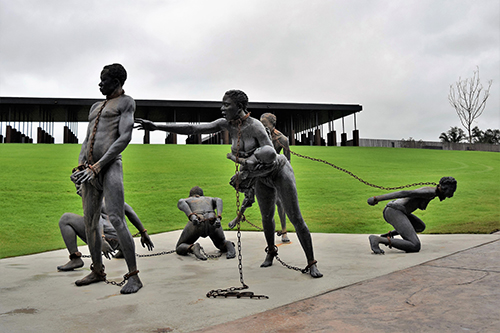
FIRST REMOVE THE FATHER FROM THE FAMILY
Ghanaian artist Kwame Akoto-Bamfo created this sculpture that stands at the entrance to the National Memorial for Peace and Justice near the site of a former warehouse where enslaved Africans were sold. The sculpture conveys the terror, brutality and dehumanizing practice of separating enslaved fathers from their families –– a practice that continues today through mass incarceration. (PHOTO BY JILL FRIEDMAN FOR COMMUNITY WORD)
BY PAM ADAMS
The average cost of an enslaved Black man in the 1800s was about $750. At $15,000 in today’s dollars, that’s not that much less than the average annual cost per inmate at many Illinois prisons.
It’s a discomforting thought. But the Equal Justice Initiative wants us to dwell on it, face it and other uncomfortable truths. For instance, three decades after the Civil War, 73 percent of Alabama’s state revenues came from leasing prison labor. The 13th Amendment ended slavery, except as punishment for convicts.
Confronting that history, says EJI founder Bryan Stevenson, is the only way to change the future.
“We have to repair all this damage,” Stevenson has said. He wants the nation to recognize the damage with the knowledge it won’t be condemned, but that there’s a more just, compassionate country on the other side.
The National Memorial for Peace and Justice makes the damage visible in a steel-column testament to thousands of lynching victims.
The lynching memorial has brought national attention and tourism to Montgomery, but it’s part of EJI’s broader Community Remembrance Project. EJI has erected markers throughout Montgomery correcting or expanding on many of the city’s other monuments and memorial markers. Communities throughout the South and beyond have already erected historical markers and collected soil from lynching sites. Jars of soil from the sites are on display at the Legacy Museum: From Enslavement to Mass Incarceration.
The lynching memorial is surrounded by replicas of each column. Residents from communities where lynchings occurred can claim the replicated column or columns representing their county.
Stevenson often talks about the impact of proximity and how spending time with prisoners changed him and his concept of the criminal justice system. Getting closer to a history of lynching and racial terrorism, he believes, can have the same healing effect in communities throughout the country.
According to EJI, monument distribution to communities probably won’t begin until later this year. Communities that have already participated in other community remembrance projects will be considered first.
